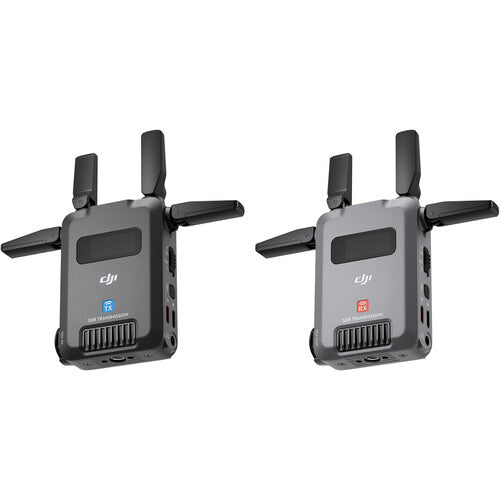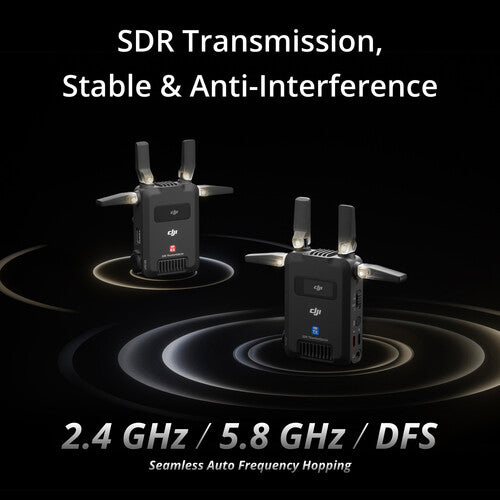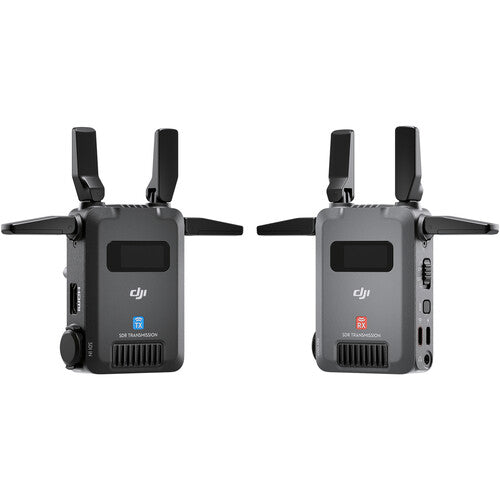Description
DJI SDR TRANSMISSION BOUNDLESS POTENTIAL
- SDR Transmission, Stable & Anti-Interference
- Strong Penetration, Extended Transmission Distance
- High Bitrate, High Image Quality
- Innovative USB-C Monitoring Experience
- Broadcast Mode, Unlimited Number of Receivers
- Ronin Compatibility & Remote Control
CHAPTER ONE: SDR TRANSMISSION, STRONG AND STABLE
Built around Software-Defined Radio technology, DJI SDR Transmission utilizes both SDR and Wi-Fi video transmission modes. SDR technology takes video transmission performance to a whole new level, offering enhanced stability, interference resistance, and penetration capabilities. For instances that require temporary monitoring, DJI SDR Transmission also accommodates Wi-Fi transmission to provide teams with increased flexibility.
|
SDR vs. Wi-Fi Transmission Performance [1] |
|
|
Transmission Distance |
Increased by 650% |
|
Transmission Bitrate |
Increased by 67% |
|
Transmission Latency |
Improved by 30% |
KILOMETER-LEVEL TRANSMISSION, ROBUST PENETRATION
DJI SDR Transmission can reach up to 3 km/10,000 ft, [1] accommodating wide-area, dynamic filming scenarios. Coupled with superior penetration capabilities, it meets on-site live feed monitoring demands in various complex scenarios.
20MBPS HIGH BITRATE, 1080P FHD IMAGE QUALITY
DJI SDR Transmission supports 1080p/60fps live feeds, with a high bitrate of up to 20 Mbps, [2] ensuring smooth monitoring and collaboration.
SEAMLESS AUTO FREQUENCY HOPPING
DJI SDR Transmission supports seamless auto frequency hopping across 2.4 GHz, 5.8 GHz, and DFS frequency bands. In case of interference, it can automatically switch to the optimal channel, effortlessly tackling complex environmental challenges.
UNLIMITED NUMBER OF RECEIVERS
In Broadcast mode, each transmitter can connect to an unlimited number of receivers, providing a high-quality monitoring experience for multiple collaborators and meeting the independent monitoring needs of various professional roles.
ADDITIONAL FEATURES
35-MILLISECOND, LOW-LATENCY TRANSMISSIONThe minimal latency of just 35 ms [3] ensures smooth monitoring and efficient collaboration. |
|
Metadata Transmission for Professional Use Cases DJI SDR Transmission supports metadata transmission from mainstream cinema cameras like ARRI and RED via SDI. This provides directors, cinematographers, and DIT teams with quick access to detailed shooting information in real time. |
COMMUNICATE WITH VOICE CALLDJI SDR Transmission enables one-on-one real-time communication [4] between the receiver and transmitter, allowing for seamless conversations between the cinematographer and the director or client at any time. |
CHAPTER TWO: AGILE AND INNOVATIVE MONITORING
COMPACT, LIGHTWEIGHT, PORTABLE
With a lightweight design and foldable antennas for easy storage, a single transmitter or receiver weighs approximately 145 g. [5] This not only ensures portability but also supports various mounting methods, satisfying a wide range of on-scene demands.
INNOVATIVE USB-C PORT, DIVERSE MONITORING METHODS
DJI SDR Transmission supports multiple monitoring methods and can output three SDR signals and two Wi-Fi signals simultaneously. The receiver can output to monitors via SDI/HDMI. Additionally, the transmitter allows for direct connection to smartphones or tablets over Wi-Fi, offering a cost-effective, dual-channel monitoring experience without the need for a receiver.
On top of this, DJI SDR Transmission also introduces a USB-C output monitoring method that combines stability with convenience. Users can use a USB-C cable to connect the receiver to a smartphone or tablet for smooth and stable monitoring.
NEWLY UPGRADED DJI RONIN APP
CAMERA INDEX SWITCHING
When DJI SDR Transmission is connected to the DJI Ronin app in Broadcast mode, users can seamlessly switch between camera indexes within the app, meeting the monitoring needs for different camera views.
LOCAL RECORDING AND PLAYBACK
The app supports local recording, and recorded content can be reviewed on the playback page.
MULTIPLE MONITORING OPTIONS
The app supports mainstream monitoring assistance tools such as LUT, peaking, waveform, and false color, delivering a professional monitoring experience.
|
LUT |
Peaking |
Waveform |
False Color |
SUPPORTIVE FEATURES
|
Control for the RS Series Stabilizers [6] Supports Force Mobile, virtual joystick, and gimbal recentering functions. |
|
Channel Settings When DJI SDR Transmission is connected to the app in SDR Control mode or Wi-Fi mode, users can switch channels within the app and monitor channel quality simultaneously. |
|
Camera Control* DJI SDR Transmission supports PTP control over cameras, displaying and adjusting aperture, shutter, ISO, and even triggering the camera's photo-taking and video-recording functions through the app. Additionally, it supports CEC control for Sony cameras, bringing Mirror Control mode into play. |
CHAPTER THREE: COMPREHENSIVE CONNECTIVITY AND POWER SUPPLY SOLUTIONS
DJI SDR TRANSMISSION TRANSMITTER PORTS
|
USB-C Port USB-C Power and Gimbal Communication Port |
|
USB-C Port USB-C Firmware Update Port |
|
3.5mm Stereo Jack Supports one-on-one voice calls. [4] |
|
HDMI Input Port Supports 1080p/60fps video input. |
|
SDI Input Port Supports 1080p/60fps video input. |
DJI SDR TRANSMISSION RECEIVER PORTS
|
USB-C Port USB-C Firmware Update and Video Output Port |
|
USB-C Port USB-C Power Port |
|
3.5mm Stereo Jack Supports one-on-one voice calls. [4] |
|
HDMI Output Port Supports 1080p/60fps video and audio output. |
|
SDI Output Port Supports 1080p/60fps video and audio output. |
VERSATILE POWER SUPPLY OPTIONS TAILORED TO YOUR NEEDS
GIMBAL POWER
Thanks to the integrated power supply design, when used with DJI RS 4 Pro, DJI RS 4, or DJI RS 3 Pro, [7] the transmitter can be mounted on the gimbal and powered directly by it, eliminating the need for a separate battery.
ALTERNATIVE POWER SUPPLY OPTIONS
NP-F POWER SUPPLY
The transmitter and receiver both support industry-standard NP-F batteries, which provide a voltage ranging from 6.8 to 8.4 V.
USB-C POWER SUPPLY
DJI SDR Transmission has increased compatibility. It can be powered through a standard PD protocol charger, with a USB-C power input rated at 9 V and 2 A











